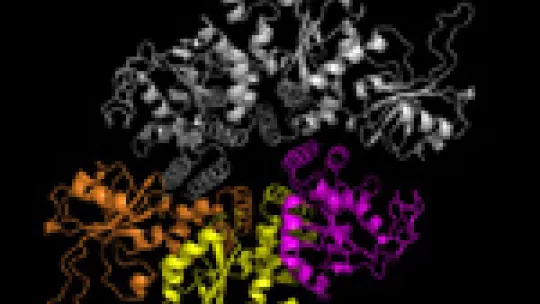Images
The study, published in the EMBO Journal, describes the structure and functions of the protein initiator of gene replication.
Plasmids are rings of DNA –double-stranded molecules that hold genetic information – that are found in most bacteria. These circular structures, which are independent of bacterial DNA, include a set of genes that favour bacterial life. Plasmid replication is undertaken by complex machinery and the description of this machinery is one of the objectives of the group headed by Miquel Coll, researcher at the Institute for Research in Biomedicine (IRB Barcelona) and research professor at the “Instituto de Biología Molecular de Barcelona”, part of the CSIC. Working with other scientists at CSIC’s “Centro de Investigaciones Biológicas” (CIB) in Madrid, Coll has determined the molecular structure of the protein RepB and has described how it operates as the initiator of replication. EMBO Journal has published the results of the study, whose first author is Roeland Boer, post-doc researcher at IRB Barcelona.
“We have been studying the replication machinery of bacterial plasmids for 10 years and during this period we have described the structure of several of the proteins involved in the process. Our interest lies in the fact that plasmids hold encrypted genes that confer bacterial virulence and antibiotic resistance”, explains Miquel Coll. Furthermore, in addition to replicating autonomously, plasmids also have the capacity to transfer from bacteria to bacteria, thereby extending resistance to antibiotics, which is a major public health concern.
The researchers headed by Miquel Coll, in collaboration with Gloria del Solar’s and Manuel Espinosa’s teams at CIB, have solved a high resolution 3D structure of RepB and describe its functions. The scientists have worked with a plasmid from Streptococcus, a bacterium that causes pneumonia in humans.
Plasmid replication
Plasmid DNA replication always starts in the same place and uses a rolling circle mechanism. At the start point, there is an extruded hairpin in the DNA that RepB protein latches onto in order to start replication. The researchers have discovered that the initiator protein is a hexameric ring and, as such, holds six active sites and six DNA binding sites, which, in addition are mobile. These features confer the protein the capacity to recognise the origin of replication, to cut one of the DNA strands, presumably to encircle the other strand helping to unwind the double helix so that the replication machinery –the replisome- can advance along the DNA and, finally, to join the cleaved strand of DNA again, completing the plasmid circle.
The structure of protein RepB shows similarities with a family of ring helicases that are involved in several processes associated with DNA, for example in viral replication. In particular, the researchers have observed that the structure of one part of RepB is similar to the replication initiators of two viruses that cause cancer in humans: the human papilloma virus (uterus) and the SV40 virus (mesotheliomas). According to Coll, this structural correlation indicates the evolutionary relation between the mechanisms and proteins involved in the replication of plasmids and viruses.
Reference article:
Plasmid replication initiator RepB forms an hexamer reminiscent of ring helicases and has mobile nuclease domains.
D Roeland Boer, Jose A Ruíz-Masó, José R López-Blanco, Alexander G Blanco, Mireia Vives-Llàcer, Pablo Chacón, Isabel Usón, F Xavier Gomis-Rüth, Manuel Espinosa, Oscar Llorca, Gloria del Solar and Miquel Coll
The EMBO Journal advance online publication, 14 May 2009; doi:10.1038/emboj.2009.125
About IRB Barcelona
The Institute for Research in Biomedicine (IRB Barcelona) pursues a society free of disease. To this end, it conducts multidisciplinary research of excellence to cure cancer and other diseases linked to ageing. It establishes technology transfer agreements with the pharmaceutical industry and major hospitals to bring research results closer to society, and organises a range of science outreach activities to engage the public in an open dialogue. IRB Barcelona is an international centre that hosts 400 researchers and more than 30 nationalities. Recognised as a Severo Ochoa Centre of Excellence since 2011, IRB Barcelona is a CERCA centre and member of the Barcelona Institute of Science and Technology (BIST).





